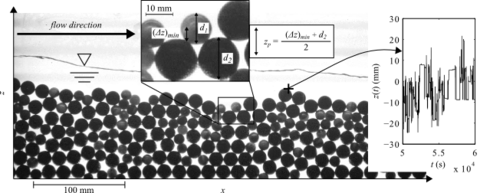Contact:
Name:
Martin, Raleigh L.
Institution:
University of Pennsylvania; University of California Los Angeles
contributor_email:
Experiments with marbles in Penn Sediment Dynamics flume. Steady water and particle feed for each experiment, but variations in particle feed rate among experiments.
Channel width ~19 cm, particles only slightly smaller (D1 ~ 12 mm, D2 ~ 16 mm). Thus, dynamics are quasi-2d.
Three types of image data captured:
1. High speed videos (with frame rates ranging from 240-1000 Hz) captured with Phantom High Speed camera. These were intended to capture dynamics of particle collisions and damage propogation.
2. Time lapse photos (with frame rates ranging from 0.1-0.5 Hz) captured with Nikon D5000 (for experiments up to 26Jan2013) and Nikon D5200 (for subsequent experiments). These were intended to explore evolution of the sedimentary bed and particle waiting times through time.
3. Webcam videos (with frame rate of 30 Hz) captured with Logitech webcam. The webcam was set up at the end of the flume, and it is hoped that these videos can help to extract the particle flux.
Not all types of data were collected for all experiments. The details of the individual experiments can be found in the "Notes" files with the associated dates of the experiments.
The "RawData" folders contain the original images from the various cameras (as well as the associated settings files for creating these images). The "ProcessedData" folders contain processed images (cropped and rotated) for the relavant imaging area. They also contain esimates of bed surface elevations and particle centroids determined by image analysis.
The experiments with TimeLapse have been renamed for publication, with the title including the feed rate for the experiments. These are:
S12 -- 16Jul2013
S30 -- combined 2Nov2012 and 13Nov2012
S60 -- 26Jan2013
S90 -- 09Aug2013
S120 -- 31Jul2013
The "ProcessedData" folders also contain the scripts used for processing the data. This has been done by a combination of Fiji (.ijm), Python (.py), and MATLAB (.m) scripts. The '09Aug2013' folder contains the latest scripts for analysis of timelapse experiments. The important ones are:
MODULE_images.py -- a module to be called by other Python scripts when processing the images
process_timelapse.py -- rotates and crops images, then spits them back out into "ProcessedImages" folder as .jpgs. Note: need to look at some raw images to get parameters for processing.
extract_bedsurface.py -- reads in processed images and estimates bed surface elevation (in pixels), spits out text files into "BedSurface" with bed surface elevations. Note, need to look at some processed to get parameters for processing.
particles_FIJI.ijm -- reads in processed images and determines centroids (in pixels) of all particles. Avoids particles on edges of image. Spits out .csv files with these coordinates into "Particles" folder. Note, need to look at some raw images to get parameters for processing.
BedSurfaceMATLABimport.m -- reads in .txt bed surface pixel elevations and converts to bed surface elevations in mm in a single .mat file which can be used for subsequent analysis
ParticlesMATLABimport.m -- reads in .csv particle files and links together into particle trajectories, saving as a single .mat file with all positions trajectories in mm.
The two "useful" processed data files are "[DATE]_BedSurface.mat" (with bed surface elevations) and "[DATE]_Particles.mat" with particle trajectories.
See the '26Jan2013' processed data folder for most up-to-date scripts for processing high-speed videos. Probably, it would be better to use some of the scripts described above for these data, but I just haven't had the chance to revisit the high-speed videos in a while. The functions of the scripts are pretty self-explanatory from the titles. The data contained in the folder are:
'V[].mat' contains particle trajectory information. Similar to the "[DATE]_Particles.mat" file described above for time-lapse. 'V[].xls' contains the particle centroids determined by Fiji image analysis. 'V[]_bedsurface.mat' contains bed surface elevations, similar to file described above for time-lapse. 'V[]_movie.mat' and '....tif' contain movies of particle motions as cartoons with hollow spheres and particle identifiers instead of the raw images. Useful for locating particle indices when looking at the trajectory files for analysis.
Date Last Updated:
Friday, January 10, 2014
Image:

Language:
English
Rights management:
CC-BY
Coverage:
Location:
Geolocation is 39.9507247, -75.191285
Dates Collected:
Friday, November 2, 2012 to Wednesday, July 31, 2013
Resource Type:
dataset
Degree of processing:
1: processed